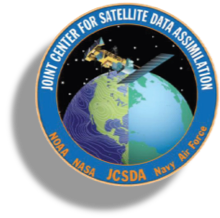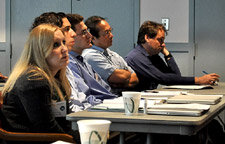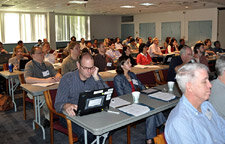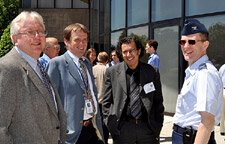JCSDA 8th Workshop on Satellite Data Assimilation
May 4-5, 2010
University of Maryland at Baltimore County (UMBC)
1450 South Rolling Road, Halethorpe, MD 21227 (Parking is free)
Group photo of attendees at the JCSDA 2010 Workshop, May 2010
Agenda and Presentations
Day 1: Tuesday, May 4th, 2010
JCSDA Management, Partner Presentations and Working Group Reports
9:00 - 10:00 Registration
10:00 - 12:00 Plenary Session
10:00 - 10:05 Review of the Program and Agenda, Dr. Sid-Ahmed Boukabara, JCSDA Deputy Director
10:00 - 10:10 Welcome from JCSDA Management Oversight Board, Col. Mark Zettlemoyer, JCSDA MOB Chair
10:10 - 10:40 JCSDA program update and overview, Dr. Lars Peter Riishojgaard, JCSDA Director
10:40 - 11:00 NESDIS data assimilation activities, Dr. Sid-Ahmed Boukabara, JCSDA Deputy Director
11:00 - 11:20 NCEP satellite data assimilation overview, Dr. Steve Lord, EMC Director
11:20 - 11:40 Satellite Assimilation Activities at NRL, Ms. Patricia Phoebus, NRL Associate
11:40 - 12:00 USAF Data Assimilation Activities, Dr. John Zapotocny, AFWA Chief Scientist
12:00 - 1:30 Lunch
1:10 - 2:45 Session 1: Partner Presentations and Working Group Reports (cont'd.)
1:10 - 1:25 CRTM Working Group Report, Dr. Paul van Delst, EMC and Dr. Yong Han, STAR
1:25 - 1:40 Microwave Sensors Working Group Report, Dr. Fuzhong Weng and Dr. Steve Swadley
1:40 - 1:55 Land Data Assimilation Working Group Report/Plan, Mike Ek (NCEP), Christa Peters-Lidard (NASA/GSFC), John Eylander (AFWA)
1:55 - 2:10 Air Composition Working Group Report, Dr. Shobha Kondragunta, STAR and Co-Chair Doug Westphal (NRL)
2:10 - 2:25 Ocean Report Assimilation Working Group Plan, Dr. Hendrik Tolman, EMC and Jim Cummings, NRL
2:25 - 2:45 GMAO Data Assimilation Overview, Dr. Michele Rienecker, Head, GMAO
2:45 - 3:15 Break
3:15 - 5:15 Session 2: Selected Oral Presentations (contributed topics)
3:15 - 3:30 The Simulation of Doppler Wind Lidar Observations in Preparation for ESA's ADM-Aeolus Mission, W. McCarty, NASA/GSFC/GMAO
3:30 - 3:45 CMAQ PM2.5 Forecasts Adjusted To Errors In Model Wind Fields, E-S. Yang, University of Alabama in Huntsville
3:45 - 4:00 Real-Time Air Quality Modeling System Aerosol and Ozone Assimilation and Forecasting Experiments During the NOAA ARCPAC Field Mission, R. B. Pierce, NESDIS/STAR
4:00 - 4:15 Profiling the Boundary Layer and Free Tropospheric Water Vapor with GPS RO, Rob Kursinski, University of Arizona
4:15 - 4:30 DTC GSI Testing and Evaluation, K. Crosby, NCAR
4:30 - 4:45 Near-Surface Sea Temperature (NSST) and Satellite Data Assimilation, X. Li, NWS/EMC
4:45 - 5:00 UTLS Ozone Assimilation in GEOS-5: EOS-MLS Results and NPP-OMPS Planning, S. Pawson, NASA/GMAO, P. Xu, V. Yudin
5:00 - 5:15 Update on LBLRTM and MonoRTMdevelopment, Eli Mlawer, AER Inc.
5:15 Adjourn
Day 2: Wednesday, May 5th, 2010
Oral Presentations & Poster Presentations
Group Discussions
Final Plenary Session
9:00 - 10:30 Selected oral presentations
9:00-9:15 NCEP Support for JCSDA Development, S. Lord, EMC; J. Derber, K. Mitchell, C. Long
9:15-9:30 STAR Support for JCSDA Development, F. Weng, STAR, Y. Han, B. Yan, M.Liu, Y. Chen, R. Vogel, M. Kim, T. Zhu, G. Krasowski, S. Boukabara
9:30-9:45 Status of the Radio Occultation Assimilation at NOAA, L. Cucurull, NOAA/IPA
9:45-10:00 The development of hyperspectral infrared water vapor radiance assimilation techniques in the NCEP Global Forecast System, J. Jung, CIMSS; J. Le Marshall, L.P. Riishojgaard
10:00-10:15 Assimilation of Satellite Microwave Water Vapor Sounding Channel Data in NCEP Global Forecast System (GFS), Banghua Yan, F. Weng, J Derber
10:15-10:30 GSI Data Assimilation system Community Support and Test, H. Shao, NCEP, EMC
10:30-11:00 Break
11:00-12:30 Selected oral presentations (contributed topics)
11:00-11:15 Impact of Satellite Observed Land Surface Data on NCEP Short Term Forecasting, V. Wong, NCEP/EMC -SAIC, Michael Ek, co-author, NCEP
11:15-11:30 Observation Error Characterization for Radiance Assimilation of Clouds & Precipitation, T. Greenwald, CIMMS
11:30-11:45 Modeling Altimetry Data Error for Ocean Data Assimilation, A. Kaplan, LDEO
11:45-12:00 Estimating the representation error of satellite and situ data for data assimilation into Ocean climate models, R. Miller, Oregon State University
12:00-12:15 Radiance Data Assimilation with Ensemble Kalman Filter, C. Schwartz, Z. Liu, Y. Chen, X. Huang, National Center for Atmospheric Research
12:15-12:30 Session 3
12:30 - 2:00 Lunch Break/Poster Presentations (catered)
3.1 Footprint Matching for the Advanced Technology Microwave Sounder, T. J. Kleespies, NESDIS
3.2 Modeling of Inhomogeneous Surface Properties for the Advanced Technology Microwave Sounder, T. J. Kleespies, NESDIS
3.3 Microwave land emissivity calculation in CRTMW., Zheng, NCEP/EMC
3.4 Calculation of radiative flux with the GOES derived cloud data and validation with SURFRAD Observations, J. Zeng, AET/GSFC
3.5 Progress in using ground-based GPS-met total precipitable water for cal/val of both product data and satellite retrievals, D. Birkenheuer, ESRL/GSD, S. Gutman, ESRL/GSD
3.6 ATMS NPP Preparation in the Community Radiative Transfer Model (CRTM): Spectral Function Analysis, P.V. Delst, D. Groff, W. Blackwell (MIT Lincoln Lab), L. Chidester (Utah State University, Space Dynamics Laboratory), G. De Amici (Northrop Grumman), G. Poe (NRL) and S. Swadley (NRL)
3.7 Implementation of a New Infrared Sea Surface Emissivity Model in the Community Radiative Transfer Model (CRTM)P.-V. Delst, D. Groff, J. Jung (CIMSS/University of Wisconsin), N. Nalli (STAR/Dell Perot Systems)
3.8 Validation of the Community Radiative Transfer Model (CRTM), P. Yang, Department of Atmospheric Sciences, Texas A&M University
3.9 Investigating Height Assignment Type Errors in the NCEP Global Forecast SystemJ. Jung, NESDIS
3.10 Cloudy Radiance Assimilation in NCEP GDAS, M.J. Kim, JCSDA
3.11 Preparation of the NPOESS CrIS into GSI System, Y. Chen, CIRA/CSU, JCSDA
3.12 Impact of Satellite Surface Wind Observations on the Tropical Cyclone Track ForecastsL. Bi, NRL Monterey
3.13 Comparison of infrared land surface emissivity from AIRS and MODIS for improving satellite data assimilation over desert regions, R. Vogel, NESDIS/STAR
3.14 Potential advantages of an OSS node based radiance compression approach in assimilation of hyperspectral sounding data, J-L. Moncet, AER
3.15 An improved FAST Microwave Surface Emissivity Model, FASTEM4Q.(Mark) Liu, NESDIS, S. English, F.Weng
3.16 Improving the Noah Land Model for Better Noah/CRTM Coupling and Accelerated Use of Satellite Data, Zhuo Wang, University of Arizona
2:00 - 3:30 Session 4: Breakout group discussion of JCSDA plans and priorities
CRTM Working Group
Microwave Working Group
Land Data Assimilation Working Group
Air Composition Working Group
Ocean Data Assimilation Working Group
Advanced Sensors Working Group (TBC)
3:30 - 3:45 Break
Session 5: Final Plenary
3:45 - 4:35 Summary report from group discussions (5 - 10 minutes each, same order)
CRTM Working Group Summary
Microwave Working Group Summary
Land Data Assimilation Working Group Summary
Air Composition Working Group Summary
Ocean Data Assimilation Working Group Input
Advanced Sensors Working Group Summary
4:35 - 5:00 Final Remarks JCSDA Director and Management Oversight Board
5:00 Adjourn
Some 100 scientists, representatives of JCSDA partner agencies, program managers, and JCSDA management/staff participated in the 8th Annual JCSDA Workshop on Satellite Data Assimilation, held at the University of Maryland Baltimore County, May 4 -5, 2010. The purpose of these annual workshops is to review the ongoing and planned scientific development sponsored by the Center, and to plan and coordinate future efforts. The JCSDA supports scientific development work with proposal-based, internally directed funds as well as with external grants awarded via a competitive Federally Funding Opportunity open to the broader scientific community. In addition, JCSDA individual partners undertake their own research that overlaps with JCSDA objectives.
In the first session, Director Riishojgaard presented a JCSDA Program Update and Overview, in which he highlighted progress in the development and planning of satellite data assimilation systems. Representatives of the JCSDA partner agencies then reviewed recent accomplishments at their organizations, and Chairs of the JCSDA Working Groups presented their respective progress reports.
The second and third sessions featured 36 oral and poster presentations by JCSDA investigators, related to all science priority areas (radiative transfer, advanced sensors assimilation, clouds and precipitation, land data assimilation, ocean data assimilation and atmospheric composition).
Session four consisted of breakout group discussions centered around the JCSDA science priority areas. In the final plenary, breakout group chairs summarized issues and recommendations to JCSDA management for their scientific areas. Copies of the oral presentations, poster papers, and breakout group summary reports from the workshop are all posted online. They can be downloaded from the Agenda links at right.
Introduction
The purpose of the JCSDA Science Workshop is to review the ongoing and planned scientific development sponsored by the NASA-NOAA-DOD Joint Center for Satellite Data Assimilation (JCSDA), and to plan and coordinate future efforts. The JCSDA has the following six scientific priority areas:
Radiative transfer
Clouds and precipitation
Advanced instruments
Land data assimilation
Ocean data assimilation
Air quality data assimilation
The JCSDA supports scientific development work in these areas with proposal-based, internally directed funds (JSDI) as well as with external grants awarded via a competitive Federally Funding Opportunity (FFO) open to the broader scientific community. In addition, JCSDA individual partners undertake their own research that overlaps with JCSDA objectives. It is important that all these efforts be complementary and coordinated. The JCSDA science workshop aims at facilitating this coordination. At the JCSDA Science Workshop, JCSDA Principal Investigators are expected to report on progress and participate in discussions about the progress and plans of the Joint Center. In order to create open forums for scientific collaboration between the JCSDA partners and improve the links to the external investigators, JCSDA Working Groups have been formed in a number of areas, including radiative transfer modeling, hyperspectral IR sounding, microwave sensors, air-quality and oceans. Brief overviews of the current status of the scientific work within the various Working Groups will be provided by the respective co-chairs.
Registration
There is no registration fee to attend the JCSDA science workshop. Online registration has closed; if you would like to register late to attend, send an e-mail to Sid.Boukabara@noaa.gov. This will allow us to plan the agenda and to ensure that the facilities are adequate. Participants should send their names, e-mail addresses, affiliations, and whether they will have a presentation. In case a presentation is planned, authors should indicate a title, and specify if an oral presentation is preferred or a poster.
Registration is requested by April 16th, 2010.
Presentation Information
Oral Presentation Format
Please refer to the program for your session date and time. Each author has 15 minutes for their presentation, with approximately 12 minutes given for the presentation followed by 3 minutes for questions and answers. Please send your presentation file to Ninghai.Sun@noaa.gov with a copy to Sid.Boukabara@noaa.gov, preferably no later than April 30th 2010 so that it can be loaded onto the JCSDA laptop computer and posted to the JCSDA website. Last minute uploads can be accommodated. In this case, presenters are asked to approach the technical staff (Ninghai Sun) no later than during the break before the start of the session.
Meeting Room Standard Equipment
Each meeting room is equipped with the following:
One data/video projector
One PC
One podium microphone
One screen of appropriate size
We encourage you to use the JCSDA supplied computer. The JCSDA computer will have the following software installed: Microsoft Windows XP, Microsoft Office 2003, Adobe Acrobat 7.x or higher, QuickTime 6.x or higher, Macromedia Flash Player 7.x or higher, and Internet Explorer 6.x or higher.
Please note that the JCSDA supplied computer does not run Microsoft Vista. All presentations created using PowerPoint 2007 should be saved as a PowerPoint 2003 file or as a .pdf and should be tested on a Windows XP machine prior to the meeting.
Please bring your presentation on one of the following media:
USB flash drive
CD-ROM, CD-R, or DVD
Note: If your graphics or video clips are not embedded in your presentation, please be sure that you bring them in a separate file as well.
Note on Mac-produced presentations
If your presentation was created on a MAC and converted to run on a PC please test it before you come to the meeting. Make sure that the hyperlinks still function. Avoid using a rewritable CD (CD-RW). We've encountered compatibility problems with them.
If your presentation was produced on a Mac and it includes embedded video, your video will most likely NOT play automatically on the PC platform. You will need to either convert your .mov files to .avi format or create a link in your slide show to an external .mov file. If you choose the latter, your animation will play in a separate QuickTime window, outside of your PowerPoint presentation. We strongly recommend that you test your Mac-produced presentation on a Windows based system before arriving at the meeting.
Questions
All questions regarding audio/visual or computer support should be sent via e-mail to Sid.Boukabara@noaa.gov. On-site, please stop by the registration desk.
Poster Information
The Poster Session Format
Please refer to the program for your particular conference for viewing dates and times. Poster set up could be done anytime after the registration but before the beginning of the poster session. Tear down time is during and/or after the break following session 4 (breakout group discussion).
Poster Display Panels and Support Equipment/Configuration
Please provide your poster in as close to a 2' x 4' (0.6096m x 1.2192m) size as possible. The preferred display will be in landscape format.
Mounting of Display Materials
You may mount your poster with the pushpins or tape.
Additional Equipment
Laptops/Computers - Should you elect to bring a laptop or personal computer, a table can be provided for you. However you must provide your own power supply. Please send an e-mail to Sid.Boukabara@noaa.gov to request a table.
Large Format Poster Printing
Many of our authors find that printing a large format poster is now the most convenient way to organize their presentation. There may also be a local print shop in your area that offers the service of large format printing. Please check the telephone Yellow Pages for printing companies.
Formatting Guidelines/Suggestions
Place the title at the top center of the poster.
Use 72 point letters.
Avoid hand drawn materials.
Keep it simple.
Do not post the pages of your paper.
Make sure it has a logical flow.
Use color, graphics, charts, and photos.
Key points should be in large type.
Do not try to tell the entire story on the panel.
Save some key points for the one-on-one discussion.
Check the program for the set up and presentation time for your session.





